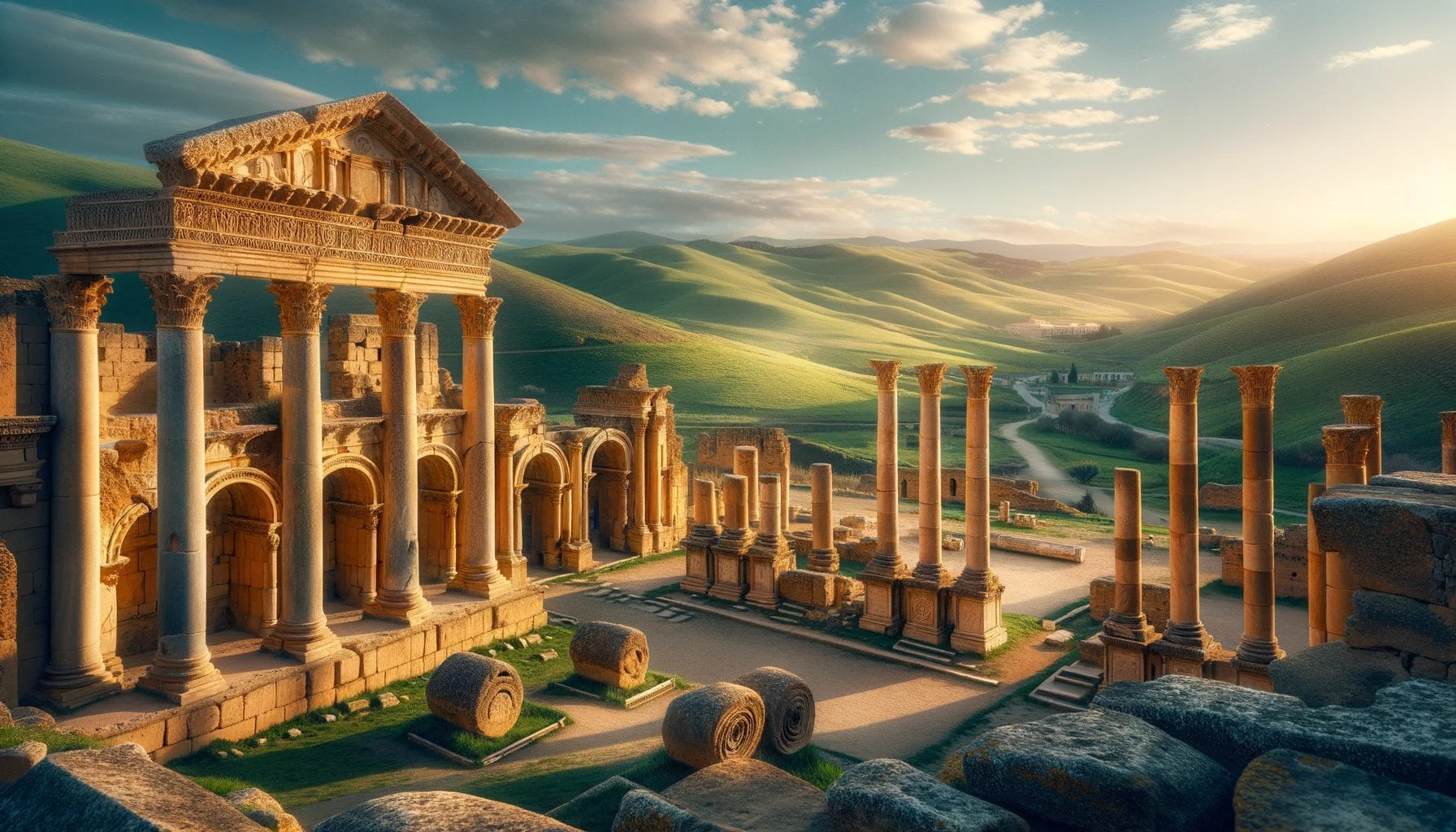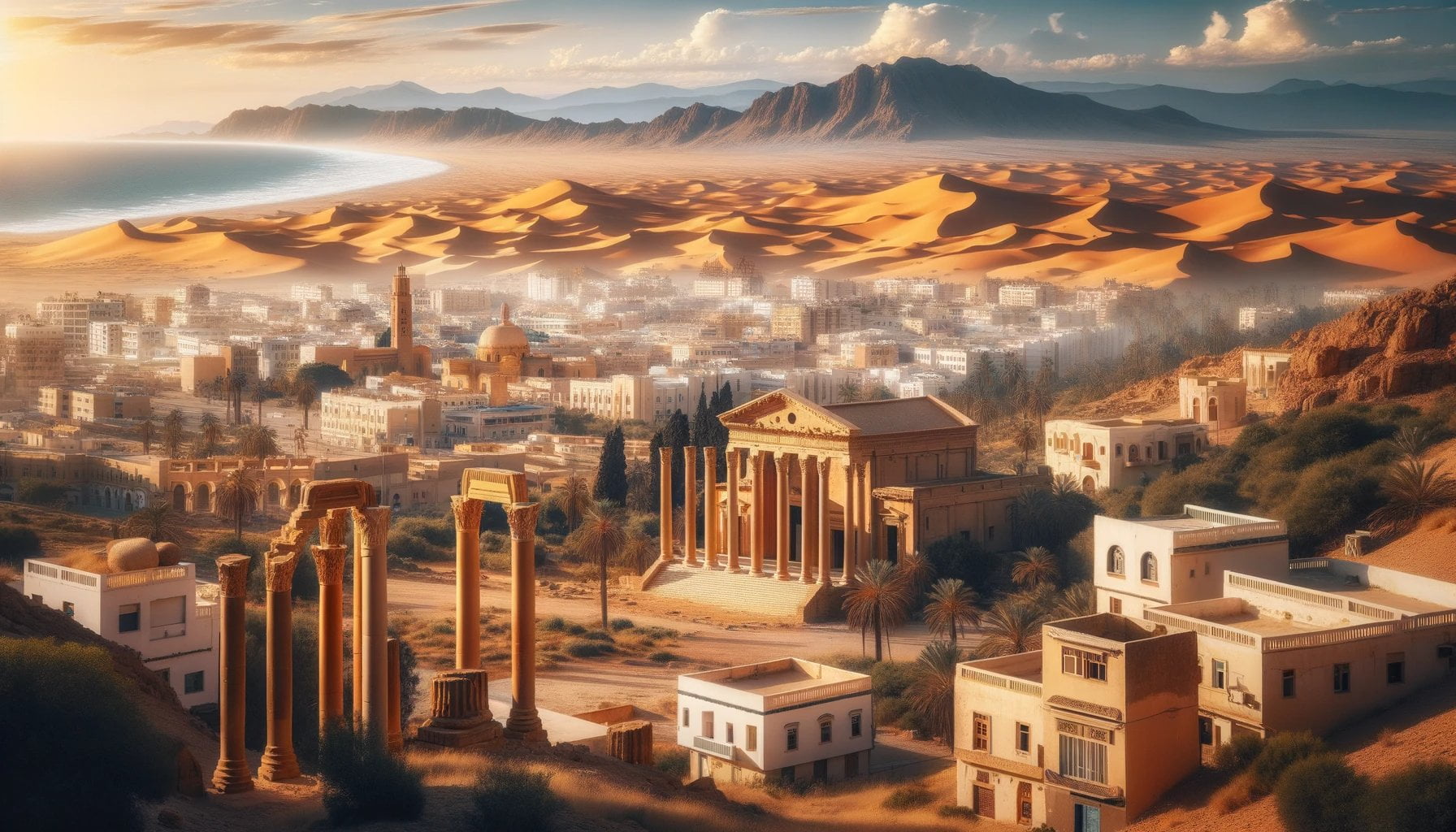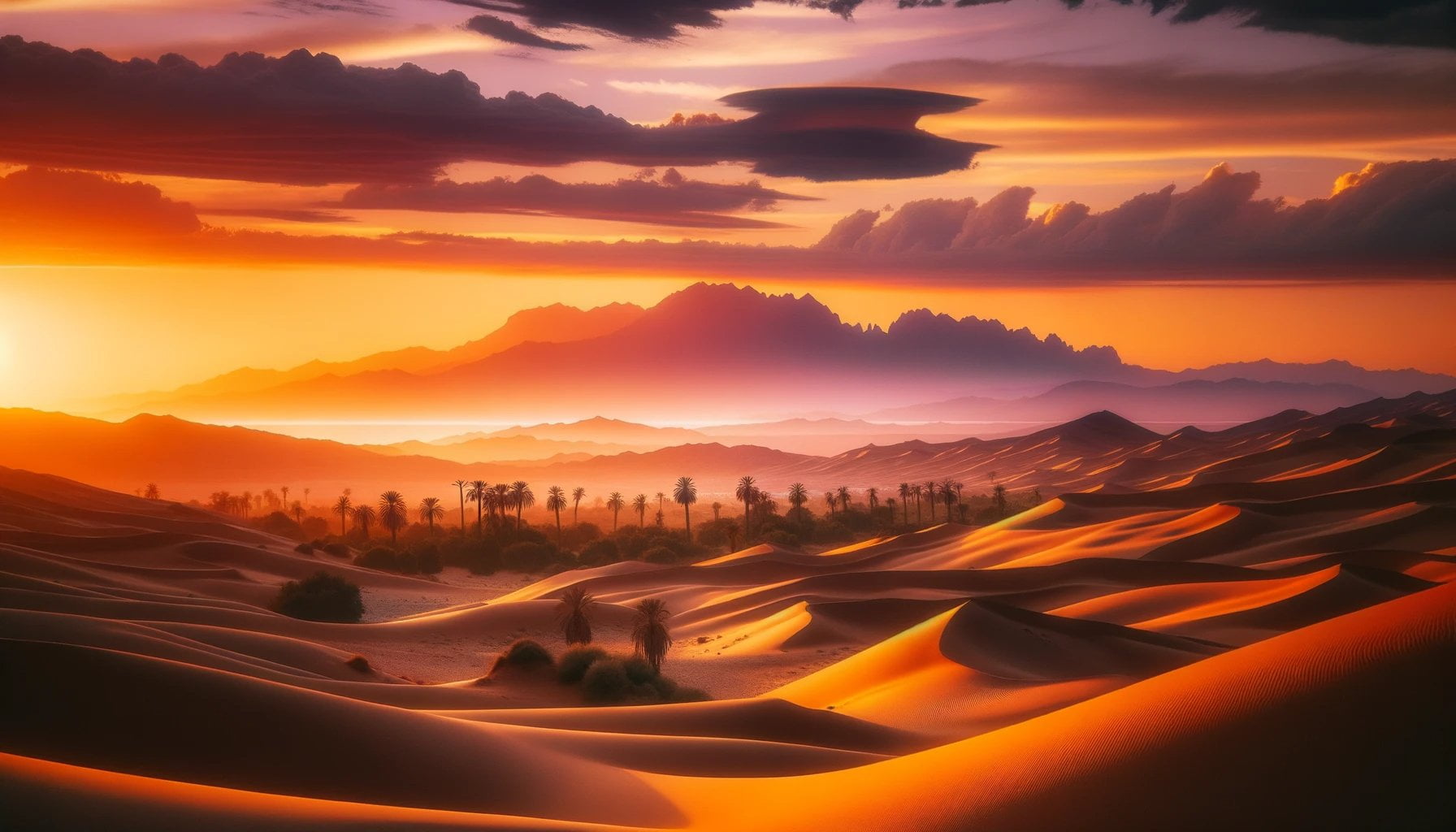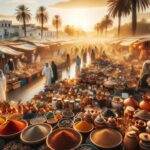Unveiling Algeria: Exploring Famous Places takes readers on a captivating journey through the renowned destinations of this North African gem. From ancient ruins to bustling marketplaces, Algeria is a treasure trove of rich history, vibrant traditions, and awe-inspiring beauty. As an experienced travel writer, I invite you to join me as we delve into the hidden gems and iconic landmarks that make Algeria a must-visit destination for any adventurer seeking to discover the wonders of this captivating land. Let’s uncover the secrets and unveil the beauty of Algeria’s famous places together.

Key Takeaways:
– Algeria has several famous places worth visiting, including Algiers, Atakor Plateau, Tamanrasset, Annaba, and Oran.
– Algiers is the capital city of Algeria and is known for its history, beautiful architecture, and the ancient Casbah.
– The Atakor Plateau, located in Ahaggar National Park, offers stunning landscapes and is worth the effort to visit.
– Tamanrasset, also known as “Tam,” is a lively town in southern Algeria that offers a modern experience.
– Annaba is a city founded by the Phoenicians and is known for its natural port and relative prosperity.
– Oran is the second largest city in Algeria, with a rich history and historical buildings to explore.
– Additional sources and URLs for further information and attractions in Algeria include “15 Best Places to Visit in Algeria” from The Crazy Tourist and “10 BEST Places to Visit in Algeria” from Tripadvisor.
Citations:
– The Crazy Tourist. “15 Best Places to Visit in Algeria.” Retrieved from source.
– Tripadvisor. “10 BEST Places to Visit in Algeria.” Retrieved from source.
Famous Places in Algeria
Algeria, a land of captivating beauty and rich history, boasts several famous places that are worth exploring. From the bustling streets of Algiers to the stunning landscapes of the Atakor Plateau, each destination is filled with its own unique charm and allure. In this article, we will take a closer look at some of the most renowned attractions in Algeria, allowing you to embark on a virtual journey through this North African gem.
Algiers: Where History Meets Beauty
As the capital city of Algeria, Algiers is a melting pot of culture, history, and architectural wonders. Algiers is famous for its ancient Casbah, a UNESCO World Heritage site that exudes old-world charm and grandeur. Strolling through its labyrinthine streets, you will discover hidden gems, such as the Ottoman-style palaces, mosques, and historic Roman ruins.
The Atakor Plateau: Nature’s Masterpiece
Nestled within Ahaggar National Park, the Atakor Plateau, also known as the Hoggar Mountains, is a paradise for nature enthusiasts. This magnificent plateau offers breathtaking landscapes, with towering peaks, rugged cliffs, and vast stretches of desert. It is a haven for hikers and outdoor adventurers, who can witness the surreal beauty of the Sahara Desert and the raw, untouched wilderness that surrounds it.
Tamanrasset: Vibrant and Modern
For those seeking a modern Algerian experience, look no further than Tamanrasset. Commonly known as “Tam,” this vibrant town in southern Algeria showcases the country’s contemporary side. Enjoy bustling markets, lively cafes, and stunning artwork displayed throughout the streets. Don’t forget to immerse yourself in the local culture by indulging in traditional Algerian cuisine and engaging with friendly locals.
Annaba: A Coastal Gem
Founded by the Phoenicians, the city of Annaba is a coastal gem that boasts a natural harbor and relative prosperity. Visit the mesmerizing Basilica of St. Augustine, a towering testament to Algeria’s colonial past. Take a leisurely stroll along the Corniche, a scenic coastal road dotted with cafes and restaurants. Capture the panoramic views of the Mediterranean Sea, immersing yourself in the serene beauty of this seaside paradise.
Oran: A Historical Haven
As the second-largest city in Algeria, Oran is a treasure trove of history and architectural wonders. Explore the ancient Casbah, reminiscent of Algiers’ charm, and the imposing Great Mosque of Oran. Delve into the city’s past at the historical museums and admire the elegant French colonial buildings that add to its charisma. With its lively atmosphere, intriguing history, and picturesque views of the Mediterranean, Oran offers an unforgettable experience for every traveler.
These famous places in Algeria are just a glimpse into the myriad of wonders that this captivating country has to offer. Each destination presents a unique blend of history, culture, and natural beauty, allowing you to embark on an extraordinary adventure. So, pack your bags, gather your curiosity, and get ready to unveil the hidden treasures of Algeria!
Here are some active internal links along with their anchor text and URLs:
- Facts about Algeria: Discover intriguing facts about Algeria, its history, culture, and cuisine.
- Tourism in Algeria: Explore the mesmerizing tourism destinations in Algeria, from stunning beaches to ancient ruins.
- Algeria culture: Immerse yourself in the vibrant and diverse culture of Algeria, where traditions and heritage prevail.
- Algeria history: Uncover the rich history of Algeria, from its ancient civilizations to the struggle for independence.
- Algeria cuisine: Indulge in the flavors of Algerian cuisine, which blends Mediterranean and Berber influences.
Happy clicking and enjoy your journey through Algeria!
The Iconic Casbah of Algiers
The Casbah of Algiers, also known as the old city or medina of Algiers, is a historic district that offers a fascinating glimpse into the rich history and cultural heritage of Algeria. As a UNESCO World Heritage site since 1992, the Casbah is not only a testament to the architectural marvels of the past but also a vibrant living community that continues to thrive amidst the modern world.
The Historical Significance:
The Casbah of Algiers holds immense historical significance, having played a pivotal role in shaping the region’s history and serving as a symbol of resistance during times of occupation and struggle. It has been a witness to the ebb and flow of civilizations, from the Phoenicians to the Ottomans, each leaving their mark on this architectural masterpiece.
Architectural Marvels:
Within the Casbah, you will find a treasure trove of well-preserved architectural gems. Notable landmarks, such as the 18th-century Ketchaoua Mosque and the iconic Notre Dame D’Afrique, showcase the blending of different cultural influences, from Moorish and Ottoman to French colonial styles. The hilltop citadel offers panoramic views that will take your breath away, allowing you to marvel at the melding of history and modernity.
Town-Planning Influence:
The influence of the Casbah of Algiers goes beyond its immediate surroundings. This historic district has influenced town-planning not only within Algeria but also in the western part of the Mediterranean and sub-Saharan Africa. Its unique layout and architecture have set a precedent for urban development, leaving an indelible mark on the region’s cultural landscape.
A Journey Through Time:
Visiting the Casbah is like stepping back in time. As you meander through its narrow alleys, you will encounter Moorish houses, ornate minarets, and hidden courtyards that whisper tales of the past. Each street corner holds a story, and every doorway invites you to explore a world steeped in tradition and charm.
Preserving the Casbah:
Although the Casbah of Algiers is a treasure worth discovering, it is also vulnerable to the effects of climate change and sea-level rise. The delicate balance between preserving its historical authenticity and adapting to modern needs poses a challenge. Efforts are underway to protect this cultural heritage and ensure its legacy for future generations to enjoy.
The Casbah’s Role in History:
Beyond its architectural beauty, the Casbah played a significant role during the Algerian War of Independence. It served as the epicenter of insurgency planning by the National Liberation Front (FLN), making it a symbol of resilience and determination in the face of oppression. Many religious buildings within the Casbah were destroyed or repurposed during the French occupation, leaving behind scars that bear testament to a tumultuous past.
Key Takeaways:
- The Casbah of Algiers is a historic district and a UNESCO World Heritage site since 1992.
- Its well-preserved architecture reflects a blend of cultural influences, from Moorish and Ottoman to French colonial styles.
- The Casbah has influenced town-planning in the western part of the Mediterranean and sub-Saharan Africa.
- Exploring the Casbah offers a journey through time, immersing you in a world of tradition and charm.
- Efforts are being made to preserve the Casbah’s historical authenticity while adapting to modern needs.
- The Casbah played a significant role during the Algerian War of Independence, serving as a symbol of resistance.
Sources:
– The Kasbah of Algiers – Direction of Tourism and Handicrafts Algiers
– Kasbah of Algiers – UNESCO World Heritage Centre
Exploring the Sahara Desert
The Sahara Desert in Algeria is a breathtaking destination that offers a unique and captivating experience for adventurers and nature enthusiasts alike. With its vast expanse of golden sand dunes and enchanting oases, the Sahara showcases the raw beauty of untouched landscapes. In this article, we will delve into the top places to visit in the Sahara Desert, giving you an insider’s perspective on the wonders that await.
Sand Seas:
One of the most awe-inspiring features of the Sahara Desert in Algeria is its expansive “Sand Seas.” These mesmerizing sand dunes create a surreal and otherworldly atmosphere, transporting you to a place of wonder and tranquility. Imagine standing amidst towering dunes, their crests shimmering in the sunlight and their ever-shifting patterns captivating your senses. The vastness of these sand seas is truly a sight to behold.
El Oued: The City of a Thousand Domes
Nestled within the Sahara Desert, the city of El Oued is a hidden gem that should not be missed. Known as “the city of a thousand domes,” El Oued is renowned for its unique architecture and breathtaking oasis. As you wander through the narrow streets, you’ll come across stunning traditional houses adorned with domes, creating a mesmerizing sight against the backdrop of the desert. The oasis itself is a lush paradise, with palm trees swaying gently in the breeze and providing a refreshing respite from the arid surroundings. El Oued offers a glimpse into the traditional way of life in the Sahara and is truly a photographer’s dream.
Timimoun: An Enchanting Oasis Town
Located in the Ardar province, Timimoun is an oasis town that exudes charm and tranquility. This enchanting destination boasts palm trees, adobe houses, and traditional markets that transport you back in time. The town’s serene ambiance offers a welcome escape from the hustle and bustle of modern life. As you explore the narrow streets, you’ll be captivated by the vibrant colors and intricate designs of the local crafts. Timimoun is a true oasis of serenity amidst the vast Sahara Desert.
M’zab Valley: A UNESCO World Heritage Site
The M’zab Valley is a true treasure in the Sahara Desert, recognized as a UNESCO World Heritage Site. It is home to five ancient desert cities collectively known as the Pentapolis: Ghardaia, Beni Isguen, El Atteuf, Melika, and Bounoura. These cities showcase the unique architecture of the Mozabite people, featuring fortified buildings and labyrinthine streets designed for protection against the harsh desert conditions. Exploring the narrow alleyways and hidden courtyards, you will be immersed in the rich history and culture of this remarkable place.
Tamanrasset: Gateway to the Sahara
Tamanrasset is a remote town located in southern Algeria and serves as a gateway to the Sahara Desert. Surrounded by stunning natural landscapes, including volcanic peaks, dramatic canyons, and vast dry riverbeds, Tamanrasset is a paradise for outdoor enthusiasts. Here, you can embark on exhilarating hiking adventures, witness the vibrant colors of the desert sunsets, and marvel at the dazzling display of stars in the clear night sky. Tamanrasset offers a unique blend of untouched natural beauty and warm hospitality, making it an ideal base for exploring the Sahara Desert.
Assekrem: A Breathtaking Viewpoint
For panoramic views of the Sahara Desert, a visit to Assekrem is a must. Located in the Ahaggar Mountains, this breathtaking viewpoint offers an unparalleled vantage point to admire the vastness and majesty of the desert. As you stand atop the mountains, you’ll be greeted by an expanse of golden sand stretching as far as the eye can see, punctuated only by the occasional tuft of vegetation. Assekrem is also renowned for its stunning sunsets, which bathe the desert in hues of orange, pink, and purple. It is a place where time seems to stand still, allowing you to connect with nature in its purest form.
Saharan National Park: A Wildlife Sanctuary
Covering an area of over 2,000 square kilometers, the Saharan National Park is a sanctuary for diverse desert wildlife. Recognized as a UNESCO World Heritage Site, this park offers a unique opportunity to observe rare and endangered species in their natural habitat. From graceful gazelles and majestic desert foxes to elusive reptiles and a variety of bird species, the Saharan National Park is a haven for wildlife enthusiasts and nature lovers. Whether you embark on a guided safari or explore the park’s hiking trails, you’ll be amazed by the resilience and beauty of the desert’s inhabitants.
Taouz Canyon: A Photographer’s Paradise
Situated within the Sahara Desert, Taouz Canyon is a picturesque site that will leave you in awe. With its towering sand dunes, contrasting colors, and diverse vegetation, this canyon is a paradise for photographers and explorers alike. As you wander through the labyrinth of canyons, you’ll be treated to breathtaking vistas at every turn. The play of light and shadow on the sand dunes creates a mesmerizing spectacle, providing endless opportunities for capturing the perfect shot. Taouz Canyon is a testament to the immense beauty and diversity of the Sahara Desert.
Key Takeaways:
- The Sahara Desert in Algeria offers stunning landscapes and unique attractions.
- The Sand Seas create a surreal and otherworldly atmosphere.
- El Oued is known as “the city of a thousand domes” and showcases unique architecture and a beautiful oasis.
- Timimoun is an enchanting oasis town with palm trees, adobe houses, and traditional markets.
- The M’zab Valley is a UNESCO World Heritage Site and home to five ancient desert cities.
- Tamanrasset serves as a gateway to the Sahara Desert and offers stunning natural landscapes.
- Assekrem provides breathtaking panoramic views of the Sahara Desert, perfect for sunsets and stargazing.
- The Saharan National Park is a UNESCO World Heritage Site and a sanctuary for diverse desert wildlife.
- Taouz Canyon is a picturesque site with towering sand dunes and diverse vegetation, ideal for photography and exploration.
Learn more:
1. Pilot Guides: Algeria: Top ten sites to visit in THE SAHARA
2. Tour Algeria: Algeria Desert: Top 10 Places to Visit in the Sahara Desert
Discovering the Roman city of Djemila
Djémila, a hidden gem nestled in the mountains of Algeria, boasts one of the most well-preserved Roman ruins in North Africa. With its unique adaptation of Roman architecture to a mountainous environment, Djémila offers a captivating glimpse into the ancient world. Let’s dive into the magnificence of this Roman city and uncover its secrets.
The Marvels of Djémila
Djémila, formerly known as Cuicul, stands as a testament to the architectural brilliance of the Roman Empire. This UNESCO World Heritage Site showcases a wide array of ruins, including a theater, two forums, temples, basilicas, arches, streets, and houses. Each structure tells a story of a bygone era, transporting visitors back in time.
The Arch of Caracalla is undoubtedly one of the highlights of Djémila. Standing tall and majestic, this triumphal arch immortalizes the Roman Emperor Caracalla. Its intricate carvings and imposing presence create an awe-inspiring sight, perfectly capturing the grandeur of the empire.
Another noteworthy monument is the Temple of Gens Septimia. Dedicated to a prominent Roman family, this temple radiates a sense of reverence and history. As you stand before its ancient walls, you can’t help but marvel at the craftsmanship and devotion that went into its construction.
And let’s not forget the 3,000-person theater, where the spirit of the gladiators lingers in the air. Imagine the roar of the crowd and the anticipation as battles unfolded on the stage. It’s a tangible reminder of the vibrant cultural scene that once thrived within Djémila’s walls.
Unraveling Djémila’s Beauty
Djémila’s location is as breathtaking as its ruins. Perched on a triangular plateau, it overlooks two rivers and is surrounded by rolling green hills. The picturesque landscape serves as a stunning backdrop for exploring the Roman city, enchanting visitors with its natural beauty.
The climate in Djémila is refreshingly cooler than the rest of northern Algeria, thanks to its elevated position. This makes it an ideal destination for those seeking respite from the scorching heat as they delve into the rich history of the region.
To embark on your journey to Djémila, you can travel to the town of Sétif, located 50 km northeast of the site. From there, various transportation options like cars or buses will take you to this ancient treasure. Once you arrive, guided tours are available to ensure you make the most of your experience, offering insights into Djémila’s history and significance.
Exploring Djémila’s Past
Delving deeper into Djémila’s history is a fascinating endeavor. Several sources provide valuable information about this Roman city and its significance. History Hit provides an insightful look into Djémila, including its origins under Emperor Nerva. The UNESCO World Heritage Centre offers detailed explanations of Djémila’s unique adaptation of Roman architecture to a mountainous environment. Global Gaz highlights Djémila as a well-preserved Roman ruin, showcasing landmarks such as the Arch of Caracalla and the Temple of Gens Septimia. For a comprehensive overview, Wikipedia provides information on Djémila’s location, history, and notable residents.
Djémila is a testament to the Roman Empire’s enduring legacy. As you explore its ruins and walk in the footsteps of ancient Romans, you’ll be transported to a bygone era of architectural mastery and cultural richness. Djémila awaits your discovery, ready to unravel its secrets and captivate your imagination.
Key Takeaways:
- Djémila, a UNESCO World Heritage Site, boasts some of the best-preserved Roman ruins in North Africa.
- The Arch of Caracalla and the Temple of Gens Septimia are must-see highlights in Djémila.
- Djémila’s location on a triangular plateau offers picturesque views of rolling green hills and two rivers.
- The climate in Djémila is cooler than the rest of northern Algeria due to its high altitude.
- Travelers can access Djémila from the town of Sétif and join guided tours to explore the ruins.
- Useful sources for learning more about Djémila include History Hit, UNESCO World Heritage Centre, Global Gaz, and Wikipedia.

FAQ
Q1: What are some famous places to visit in Algeria?
A1: Some famous places to visit in Algeria include Algiers, Atakor Plateau, Tamanrasset, Annaba, and Oran. Other notable destinations are the Sand Seas, El Oued, Timimoun, M’zab Valley, Assekrem, the Saharan National Park, and Taouz Canyon.
Q2: What is the Kasbah of Algiers?
A2: The Kasbah of Algiers is the old city or medina of Algiers, the capital of Algeria. It is a historic district known for its well-preserved architecture and significant cultural heritage. It has been recognized as a UNESCO World Heritage site since 1992.
Q3: How can I visit Djémila in Algeria?
A3: To visit Djémila, you can travel to the town of Sétif, located 50 km northeast of the site. From there, you can reach Djémila by car or bus. The site is open to visitors, and guided tours are available to explore the ruins and learn about their history.
Q4: What can I see in Djémila?
A4: In Djémila, you can see a variety of well-preserved Roman ruins, including a theatre, two fora, temples, basilicas, arches, streets, and houses. Some notable landmarks within Djémila are the Arch of Caracalla, the Temple of Gens Septimia, and a 3,000-person theatre.
Q5: What is unique about Djémila?
A5: Djémila, formerly known as Cuicul, is unique for its adaptation of Roman architecture to a mountain environment. It became a UNESCO World Heritage Site due to this unique feature. The ruins of Djémila are spread out over a large expanse, surrounded by rolling green hills, and provide a glimpse into the ancient Roman civilization in North Africa.
- Unlocking Francis Alexander Shields’ Finance Empire: A Comprehensive Biography - July 12, 2025
- Unveiling Francis Alexander Shields: A Business Legacy - July 12, 2025
- Francis Alexander Shields’ Business Career: A Comprehensive Overview - July 12, 2025















